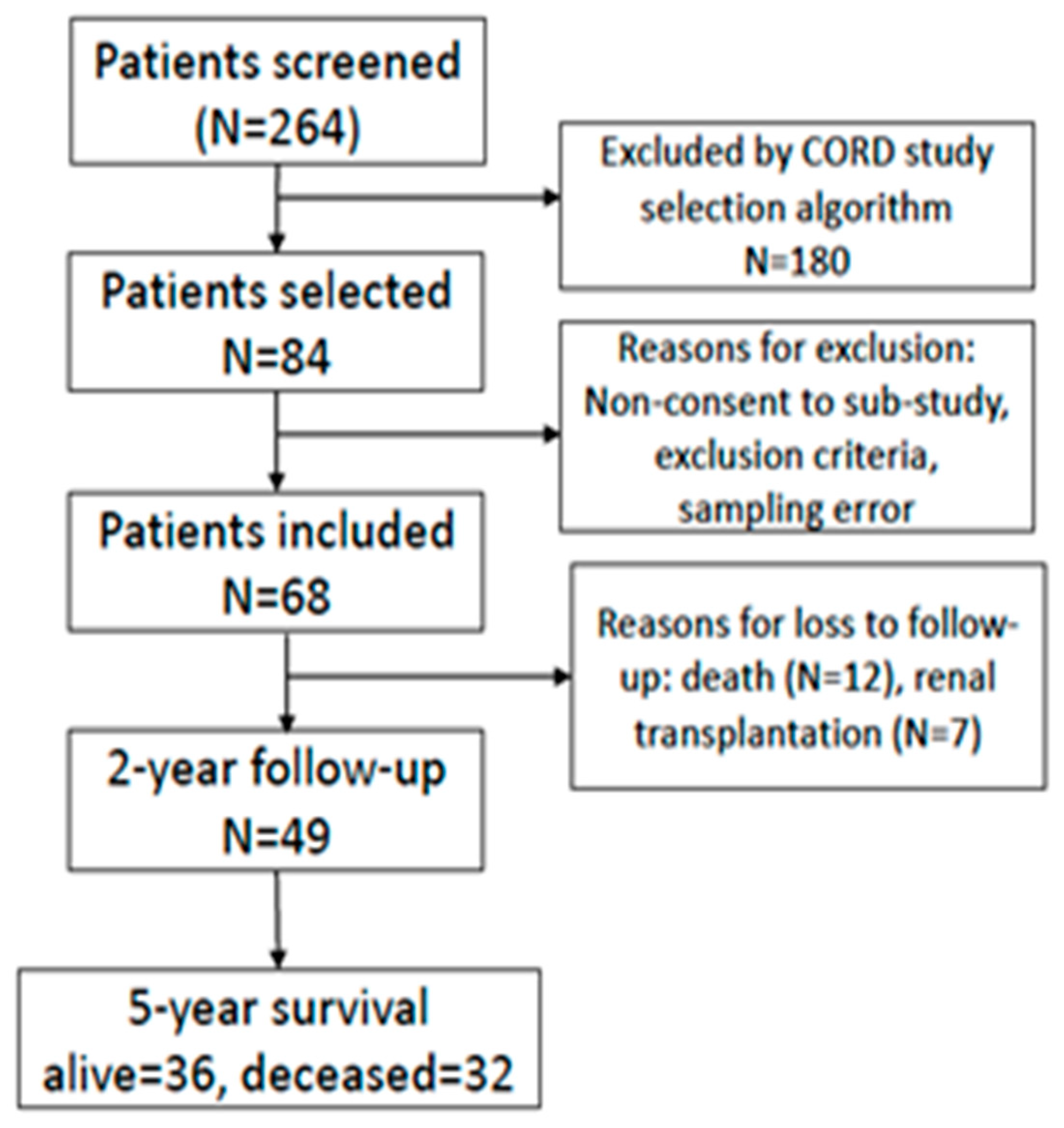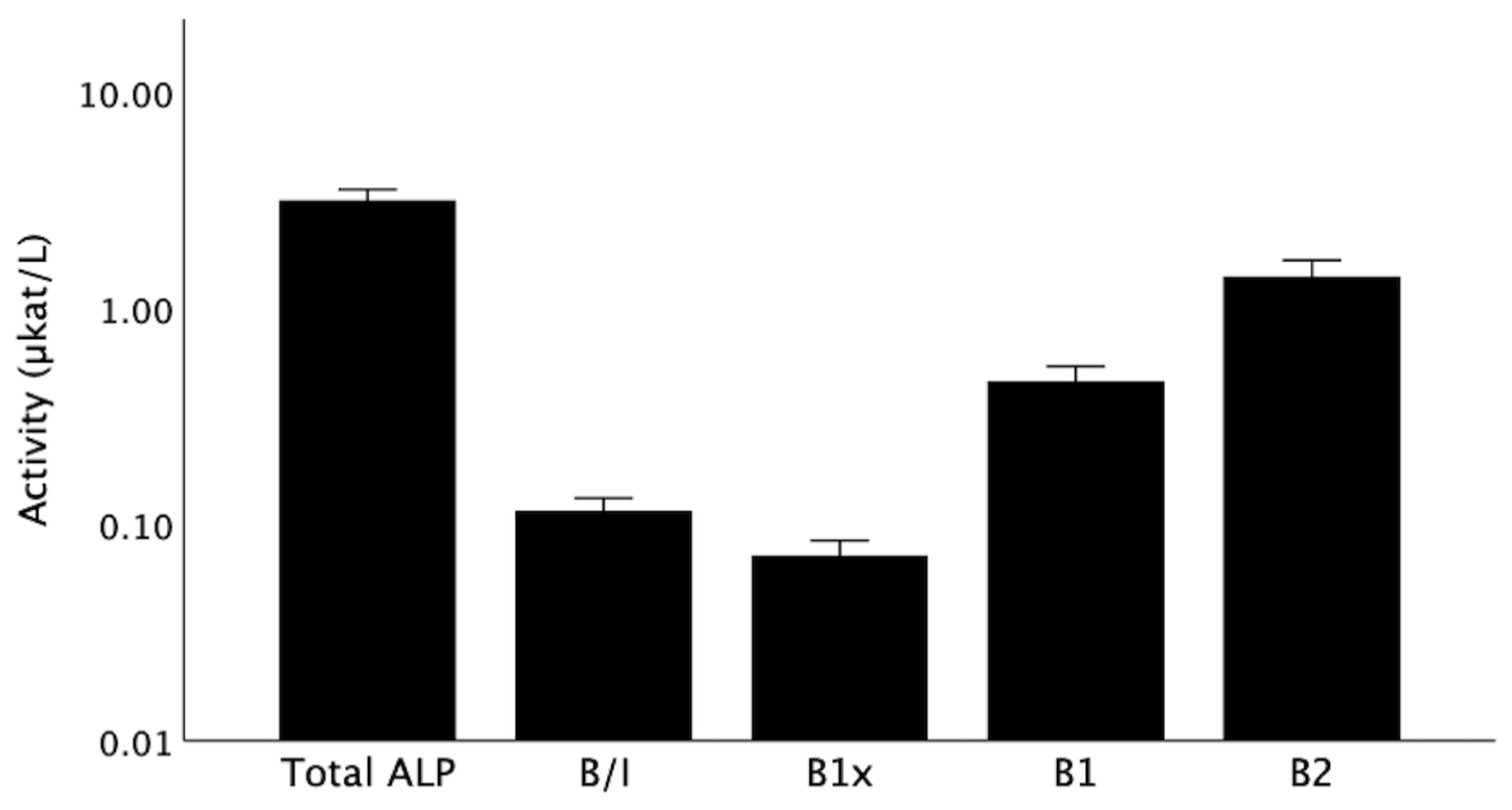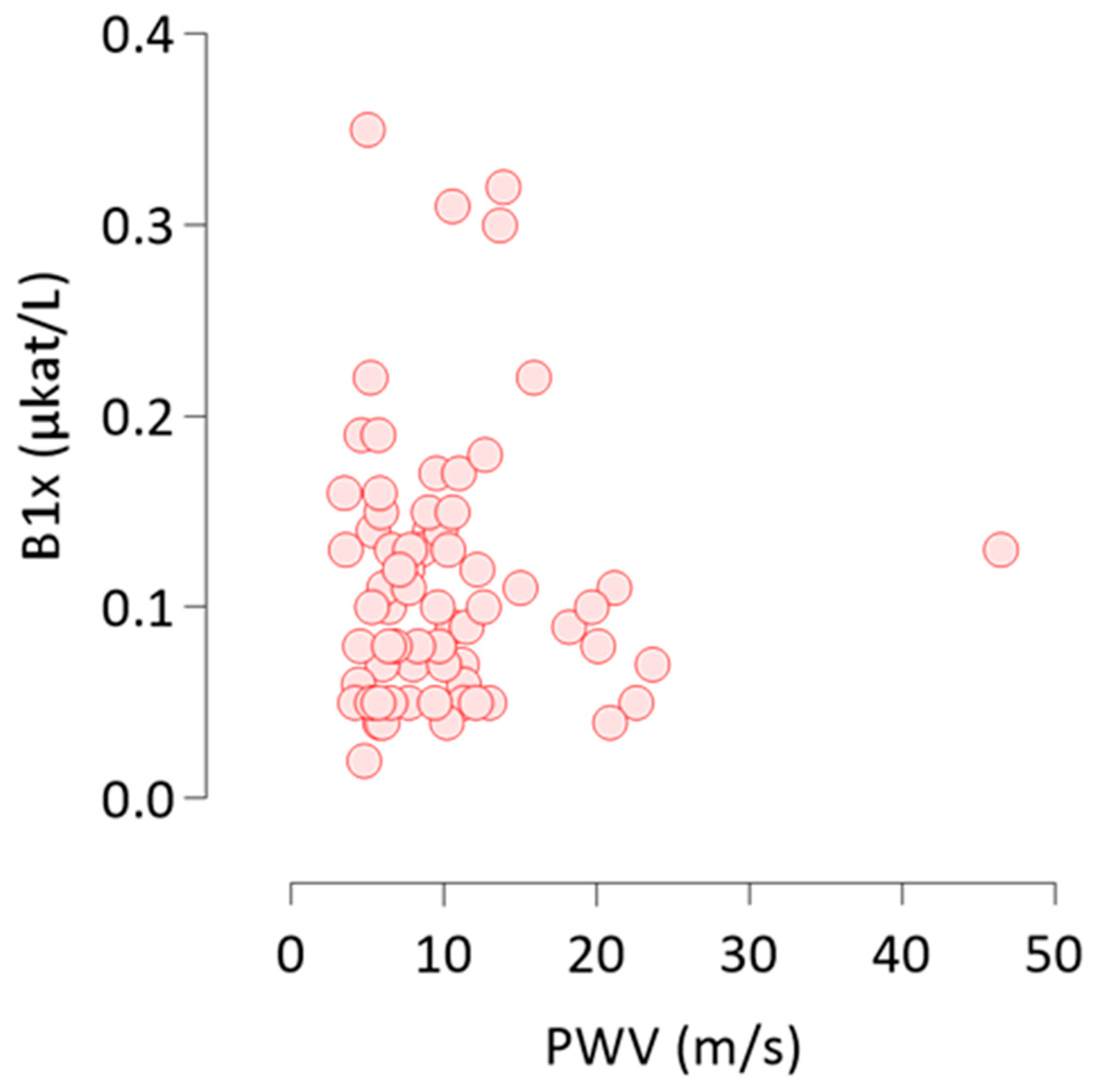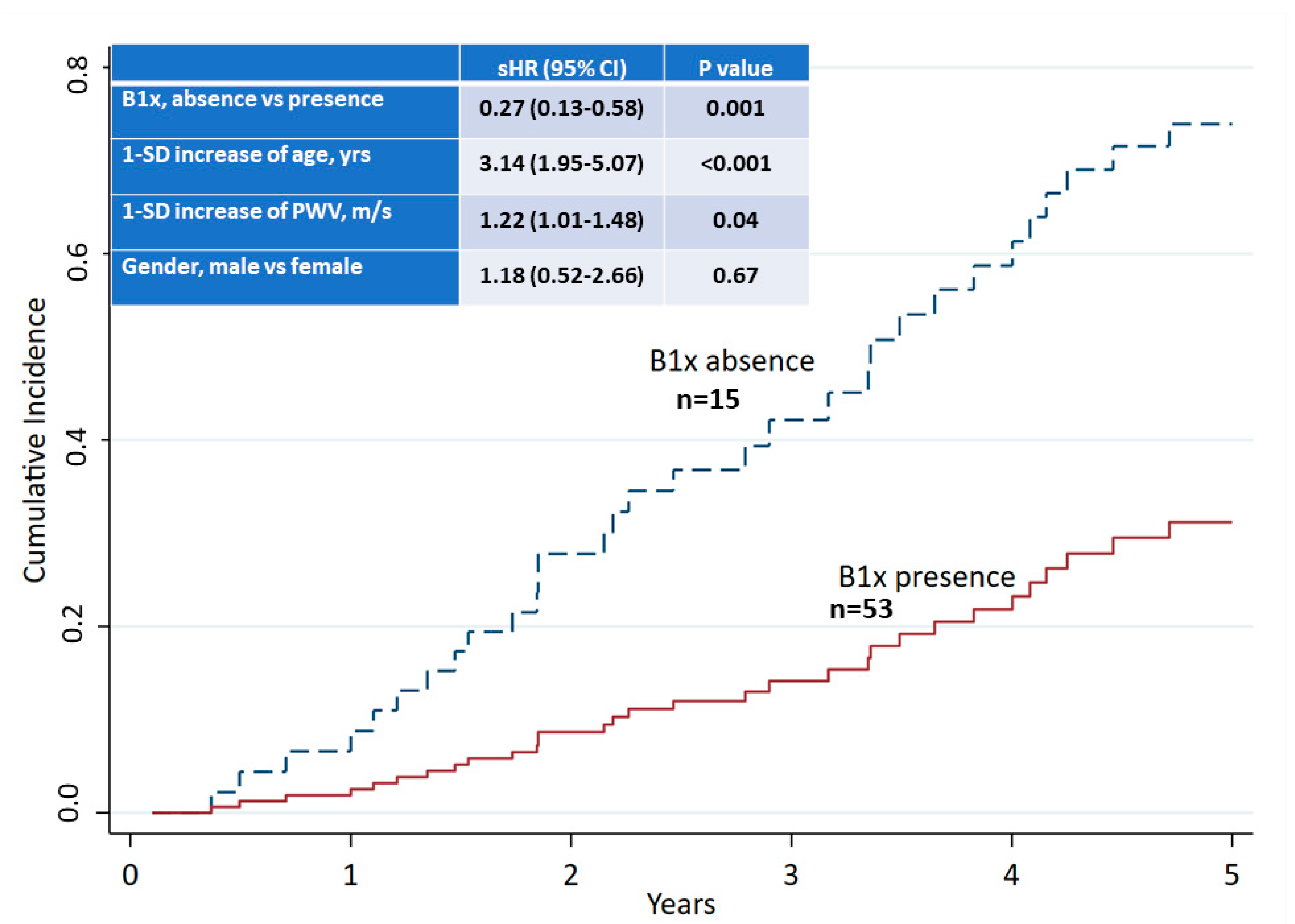The Novel Bone Alkaline Phosphatase Isoform B1x Is Associated with Improved 5-Year Survival in Chronic Kidney Disease
Abstract
1. Introduction
2. Materials and Methods
2.1. Patients
2.2. Biochemical Determinations
2.3. PWV
2.4. AAC Score
2.5. Statistical Analysis
3. Results
3.1. Patients
3.2. BALP Isoforms
3.3. PWV and AAC Score
3.4. Predictors of 5-Year Mortality
4. Discussion
Author Contributions
Funding
Institutional Review Board Statement
Informed Consent Statement
Data Availability Statement
Acknowledgments
Conflicts of Interest
References
- Allon, M. Evidence-based cardiology in hemodialysis patients. J. Am. Soc. Nephrol. 2013, 24, 1934–1943. [Google Scholar] [CrossRef] [PubMed]
- Kidney Disease: Improving Global Outcomes (KDIGO) CKD-MBD Update Work Group. KDIGO 2017 Clinical Practice Guideline Update for the Diagnosis, Evaluation, Prevention, and Treatment of Chronic Kidney Disease-Mineral and Bone Disorder (CKD-MBD). Kidney Int. Suppl. 2017, 7, 1–59. [Google Scholar] [CrossRef]
- Haarhaus, M.; Evenepoel, P. Differentiating the causes of adynamic bone in advanced chronic kidney disease informs osteoporosis treatment. Kidney Int. 2021, 100, 546–558. [Google Scholar] [CrossRef]
- Haarhaus, M.; Brandenburg, V.; Kalantar-Zadeh, K.; Stenvinkel, P.; Magnusson, P. Alkaline phosphatase: A novel treatment target for cardiovascular disease in CKD. Nat. Rev. Nephrol. 2017, 13, 429–442. [Google Scholar] [CrossRef] [PubMed]
- Drechsler, C.; Verduijn, M.; Pilz, S.; Krediet, R.T.; Dekker, F.W.; Wanner, C.; Ketteler, M.; Boeschoten, E.W.; Brandenburg, V. Bone Alkaline Phosphatase and Mortality in Dialysis Patients. Clin. J. Am. Soc. Nephrol. 2011, 6, 1752–1759. [Google Scholar] [CrossRef]
- Chen, Z.; Zhang, X.; Han, F.; Xie, X.; Hua, Z.; Huang, X.; Lindholm, B.; Haarhaus, M.; Stenvinkel, P.; Qureshi, A.R.; et al. High alkaline phosphatase and low intact parathyroid hormone associate with worse clinical outcome in peritoneal dialysis patients. Perit. Dial. Int. 2021, 41, 236–243. [Google Scholar] [CrossRef] [PubMed]
- Verbeke, F.; Van Biesen, W.; Honkanen, E.; Wikström, B.; Jensen, P.B.; Krzesinski, J.M.; Rasmussen, M.; Vanholder, R.; Rensma, P.L. Prognostic value of aortic stiffness and calcification for cardiovascular events and mortality in dialysis patients: Outcome of the calcification outcome in renal disease (CORD) study. Clin. J. Am. Soc. Nephrol. 2011, 6, 153–159. [Google Scholar] [CrossRef]
- Sigrist, M.; Taal, M.; Bungay, P.; McIntyre, C. Progressive vascular calcification over 2 years is associated with arterial stiffening and increased mortality in patients with stages 4 and 5 chronic kidney disease. Clin. J. Am. Soc. Nephrol. 2007, 2, 1241–1248. [Google Scholar] [CrossRef]
- Haarhaus, M.; Gilham, D.; Kulikowski, E.; Magnusson, P.; Kalantar-Zadeh, K. Pharmacologic epigenetic modulators of alkaline phosphatase in chronic kidney disease. Curr. Opin. Nephrol. Hypertens. 2020, 29, 4–15. [Google Scholar] [CrossRef]
- Kang, S.H.; Do, J.Y.; Kim, J.C. Association between alkaline phosphatase and muscle mass, strength, or physical performance in patients on maintenance hemodialysis. Front. Med. 2021, 8, 657957. [Google Scholar] [CrossRef]
- Haarhaus, M.; Arnqvist, H.J.; Magnusson, P. Calcifying human aortic smooth muscle cells express different bone alkaline phosphatase isoforms, including the novel B1x isoform. J. Vasc. Res. 2013, 50, 167–174. [Google Scholar] [CrossRef] [PubMed]
- Nizet, A.; Cavalier, E.; Stenvinkel, P.; Haarhaus, M.; Magnusson, P. Bone alkaline phosphatase: An important biomarker in chronic kidney disease-mineral and bone disorder. Clin. Chim. Acta 2020, 501, 198–206. [Google Scholar] [CrossRef]
- Haarhaus, M.; Ray, K.K.; Nicholls, S.J.; Schwartz, G.G.; Kulikowski, E.; Johansson, J.O.; Sweeney, M.; Halliday, C.; Lebioda, K.; Wong, N.; et al. Apabetalone lowers serum alkaline phosphatase and improves cardiovascular risk in patients with cardiovascular disease. Atherosclerosis 2019, 290, 59–65. [Google Scholar] [CrossRef]
- Magnusson, P.; Larsson, L.; Magnusson, M.; Davie, M.W.; Sharp, C.A. Isoforms of bone alkaline phosphatase: Characterization and origin in human trabecular and cortical bone. J. Bone Miner. Res. 1999, 14, 1926–1933. [Google Scholar] [CrossRef]
- Magnusson, P.; Sharp, C.A.; Farley, J.R. Different distributions of human bone alkaline phosphatase isoforms in serum and bone tissue extracts. Clin. Chim. Acta 2002, 325, 59–70. [Google Scholar] [CrossRef]
- Magnusson, P.; Sharp, C.A.; Magnusson, M.; Risteli, J.; Davie, M.W.; Larsson, L. Effect of chronic renal failure on bone turnover and bone alkaline phosphatase isoforms. Kidney Int. 2001, 60, 257–265. [Google Scholar] [CrossRef]
- Haarhaus, M.; Fernstrom, A.; Magnusson, M.; Magnusson, P. Clinical significance of bone alkaline phosphatase isoforms, including the novel B1x isoform, in mild to moderate chronic kidney disease. Nephrol Dial. Transplant. 2009, 24, 3382–3389. [Google Scholar] [CrossRef]
- Nosjean, O.; Koyama, I.; Goseki, M.; Roux, B.; Komoda, T. Human tissue non-specific alkaline phosphatases: Sugar-moiety-induced enzymic and antigenic modulations and genetic aspects. Biochem. J. 1997, 321 Pt 2, 297–303. [Google Scholar] [CrossRef] [PubMed]
- Magnusson, P.; Farley, J.R. Differences in sialic acid residues among bone alkaline phosphatase isoforms: A physical, biochemical, and immunological characterization. Calcif. Tissue Int. 2002, 71, 508–518. [Google Scholar] [CrossRef] [PubMed]
- Halling Linder, C.; Narisawa, S.; Millán, J.L.; Magnusson, P. Glycosylation differences contribute to distinct catalytic properties among bone alkaline phosphatase isoforms. Bone 2009, 45, 987–993. [Google Scholar] [CrossRef]
- HallingLinder, C.; Enander, K.; Magnusson, P. Glycation Contributes to Interaction between Human Bone Alkaline Phosphatase and Collagen Type I. Calcif. Tissue Int. 2016, 98, 284–293. [Google Scholar] [CrossRef] [PubMed]
- Anh, D.J.; Dimai, H.P.; Hall, S.L.; Farley, J.R. Skeletal alkaline phosphatase activity is primarily released from human osteoblasts in an insoluble form, and the net release is inhibited by calcium and skeletal growth factors. Calcif. Tissue Int. 1998, 62, 332–340. [Google Scholar] [CrossRef]
- Magnusson, P.; Degerblad, M.; Sääf, M.; Larsson, L.; Thorén, M. Different responses of bone alkaline phosphatase isoforms during recombinant insulin-like growth factor-I (IGF-I) and during growth hormone therapy in adults with growth hormone deficiency. J. Bone Miner. Res. 1997, 12, 210–220. [Google Scholar] [CrossRef] [PubMed]
- Swolin-Eide, D.; Hansson, S.; Larsson, L.; Magnusson, P. The novel bone alkaline phosphatase B1x isoform in children with kidney disease. Pediatr. Nephrol. 2006, 21, 1723–1729. [Google Scholar] [CrossRef]
- Haarhaus, M.; Monier-Faugere, M.C.; Magnusson, P.; Malluche, H.H. Bone alkaline phosphatase isoforms in hemodialysis patients with low versus non-low bone turnover: A diagnostic test study. Am. J. Kidney Dis. 2015, 66, 99–105. [Google Scholar] [CrossRef]
- Honkanen, E.; Kauppila, L.; Wikström, B.; Rensma, P.; Krzesinski, J.; Aasarod, K.; Verbeke, F.; Jensen, P.; Mattelaer, P.; Volck, B. Abdominal aortic calcification in dialysis patients: Results of the CORD study. Nephrol. Dial. Transplant. 2008, 23, 4009–4015. [Google Scholar] [CrossRef] [PubMed]
- Magnusson, P.; Löfman, O.; Larsson, L. Methodological aspects on separation and reaction conditions of bone and liver alkaline phosphatase isoform analysis by high-performance liquid chromatography. Anal. Biochem. 1993, 211, 156–163. [Google Scholar] [CrossRef]
- Magnusson, P.; Löfman, O.; Larsson, L. Determination of alkaline phosphatase isoenzymes in serum by high-performance liquid chromatography with post-column reaction detection. J. Chromatogr. 1992, 576, 79–86. [Google Scholar] [CrossRef]
- Kauppila, L.I.; Polak, J.F.; Cupples, L.A.; Hannan, M.T.; Kiel, D.P.; Wilson, P.W. New indices to classify location, severity and progression of calcific lesions in the abdominal aorta: A 25-year follow-up study. Atherosclerosis 1997, 132, 245–250. [Google Scholar] [CrossRef]
- Latouche, A.; Allignol, A.; Beyersmann, J.; Labopin, M.; Fine, J.P. A competing risks analysis should report results on all cause-specific hazards and cumulative incidence functions. J. Clin. Epidemiol. 2013, 66, 648–653. [Google Scholar] [CrossRef]
- van Geloven, N.; le Cessie, S.; Dekker, F.W.; Putter, H. Transplant as a competing risk in the analysis of dialysis patients. Nephrol. Dial. Transplant. 2017, 32, ii53–ii59. [Google Scholar] [CrossRef][Green Version]
- Fine, J.P.; Gray, R.J. A Proportional Hazards Model for the Subdistribution of a Competing Risk. J. Am. Stat. Assoc. 1999, 94, 496. [Google Scholar] [CrossRef]
- Feroze, U.; Molnar, M.Z.; Dukkipati, R.; Kovesdy, C.P.; Kalantar-Zadeh, K. Insights into nutritional and inflammatory aspects of low parathyroid hormone in dialysis patients. J. Ren. Nutr. 2011, 21, 100–104. [Google Scholar] [CrossRef] [PubMed][Green Version]
- Kalantar-Zadeh, K.; Shah, A.; Duong, U.; Hechter, R.C.; Dukkipati, R.; Kovesdy, C.P. Kidney bone disease and mortality in CKD: Revisiting the role of vitamin D, calcimimetics, alkaline phosphatase, and minerals. Kidney Int. Suppl. 2010, 117, S10–S21. [Google Scholar] [CrossRef] [PubMed]
- Chen, C.L.; Chen, N.C.; Wu, F.Z.; Wu, M.T. Impact of denosumab on cardiovascular calcification in patients with secondary hyperparathyroidism undergoing dialysis: A pilot study. Osteoporos. Int. 2020, 31, 1507–1516. [Google Scholar] [CrossRef]
- Iseri, K.; Watanabe, M.; Yoshikawa, H.; Mitsui, H.; Endo, T.; Yamamoto, Y.; Iyoda, M.; Ryu, K.; Inaba, T.; Shibata, T. Effects of Denosumab and Alendronate on Bone Health and Vascular Function in Hemodialysis Patients: A Randomized, Controlled Trial. J. Bone Miner. Res. 2019, 34, 1014–1024. [Google Scholar] [CrossRef] [PubMed]
- Hortells, L.; Sosa, C.; Guillén, N.; Lucea, S.; Millán, A.; Sorribas, V. Identifying early pathogenic events during vascular calcification in uremic rats. Kidney Int. 2017, 92, 1384–1394. [Google Scholar] [CrossRef] [PubMed]
- Carrillo-López, N.; Martínez-Arias, L.; Alonso-Montes, C.; Martín-Carro, B.; Martín-Vírgala, J.; Ruiz-Ortega, M.; Fernández-Martín, J.L.; Dusso, A.S.; Rodriguez-García, M.; Naves-Díaz, M.; et al. The receptor activator of nuclear factor κΒ ligand receptor leucine-rich repeat-containing G-protein-coupled receptor 4 contributes to parathyroid hormone-induced vascular calcification. Nephrol. Dial. Transplant. 2021, 36, 618–631. [Google Scholar] [CrossRef]
- Fedde, K.N.; Lane, C.C.; Whyte, M.P. Alkaline phosphatase is an ectoenzyme that acts on micromolar concentrations of natural substrates at physiologic pH in human osteosarcoma (SAOS-2) cells. Arch. Biochem. Biophys. 1988, 264, 400–409. [Google Scholar] [CrossRef]
- Fedde, K.N. Human osteosarcoma cells spontaneously release matrix-vesicle-like structures with the capacity to mineralize. Bone Miner. 1992, 17, 145–151. [Google Scholar] [CrossRef]
- Farley, J.; Magnusson, P. Effects of tunicamycin, mannosamine, and other inhibitors of glycoprotein processing on skeletal alkaline phosphatase in human osteoblast-like cells. Calcif. Tissue Int. 2005, 76, 63–74. [Google Scholar] [CrossRef]
- Debray, J.; Chang, L.; Marques, S.; Pellet-Rostaing, S.; Le Duy, D.; Mebarek, S.; Buchet, R.; Magne, D.; Popowycz, F.; Lemaire, M. Inhibitors of tissue-nonspecific alkaline phosphatase: Design, synthesis, kinetics, biomineralization and cellular tests. Bioorganic Med. Chem. 2013, 21, 7981–7987. [Google Scholar] [CrossRef]
- Sheen, C.R.; Kuss, P.; Narisawa, S.; Yadav, M.C.; Nigro, J.; Wang, W.; Chhea, T.N.; Sergienko, E.A.; Kapoor, K.; Jackson, M.R.; et al. Pathophysiological role of vascular smooth muscle alkaline phosphatase in medial artery calcification. J. Bone Miner. Res. 2015, 30, 824–836. [Google Scholar] [CrossRef] [PubMed]
- Guerin, A.P.; Blacher, J.; Pannier, B.; Marchais, S.J.; Safar, M.E.; London, G.M. Impact of aortic stiffness attenuation on survival of patients in end-stage renal failure. Circulation 2001, 103, 987–992. [Google Scholar] [CrossRef]
- London, G.M.; Pannier, B.; Guerin, A.P.; Blacher, J.; Marchais, S.J.; Darne, B.; Metivier, F.; Adda, H.; Safar, M.E. Alterations of left ventricular hypertrophy in and survival of patients receiving hemodialysis: Follow-up of an interventional study. J. Am. Soc. Nephrol. 2001, 12, 2759–2767. [Google Scholar] [CrossRef] [PubMed]
- Fischer, E.I.C.; Bia, D.; Galli, C.; Valtuille, R.; Zocalo, Y.; Wray, S.; Armentano, R.L. Hemodialysis decreases carotid-brachial and carotid-femoral pulse wave velocities: A 5-year follow-up study. Hemodial. Int. 2015, 19, 419–428. [Google Scholar] [CrossRef]
- Bonet, J.; Bayes, B.; Fernandez-Crespo, P.; Casals, M.; Lopez-Ayerbe, J.; Romero, R. Cinacalcet may reduce arterial stiffness in patients with chronic renal disease and secondary hyperparathyroidism-results of a small-scale, prospective, observational study. Clin. Nephrol. 2011, 75, 181–187. [Google Scholar] [CrossRef] [PubMed]
- Utescu, M.S.; Couture, V.; Mac-Way, F.; De Serres, S.A.; Marquis, K.; Lariviere, R.; Desmeules, S.; Lebel, M.; Boutouyrie, P.; Agharazii, M. Determinants of progression of aortic stiffness in hemodialysis patients: A prospective longitudinal study. Hypertension 2013, 62, 154–160. [Google Scholar] [CrossRef]
- Levin, A.; Tang, M.; Perry, T.; Zalunardo, N.; Beaulieu, M.; Dubland, J.A.; Zerr, K.; Djurdjev, O. Randomized Controlled Trial for the Effect of Vitamin D Supplementation on Vascular Stiffness in CKD. Clin. J. Am. Soc. Nephrol. 2017, 12, 1447–1460. [Google Scholar] [CrossRef]
- Gao, Z.; Li, X.; Miao, J.; Lun, L. Impacts of parathyroidectomy on calcium and phosphorus metabolism disorder, arterial calcification and arterial stiffness in haemodialysis patients. Asian J. Surg. 2019, 42, 6–10. [Google Scholar] [CrossRef] [PubMed]
- Haimovici, H.; Maier, N. Fate of Aortic Homografts in Canine Atherosclerosis. 3. Study of Fresh Abdominal and Thoracic Aortic Implants into Thoracic Aorta: Role of Tissue Susceptibility in Atherogenesis. Arch. Surg 1964, 89, 961–969. [Google Scholar] [CrossRef]
- Shanahan, C.; Cary, N.; Salisbury, J.; Proudfoot, D.; Weissberg, P.; Edmonds, M. Medial localization of mineralization-regulating proteins in association with Mönckeberg’s sclerosis: Evidence for smooth muscle cell-mediated vascular calcification. Circulation 1999, 100, 2168–2176. [Google Scholar] [CrossRef]
- Leroux-Berger, M.; Queguiner, I.; Maciel, T.T.; Ho, A.; Relaix, F.; Kempf, H. Pathologic calcification of adult vascular smooth muscle cells differs on their crest or mesodermal embryonic origin. J. Bone Miner. Res. 2011, 26, 1543–1553. [Google Scholar] [CrossRef]
- Wennberg, C.; Hessle, L.; Lundberg, P.; Mauro, S.; Narisawa, S.; Lerner, U.H.; Millán, J.L. Functional characterization of osteoblasts and osteoclasts from alkaline phosphatase knockout mice. J. Bone Miner. Res. 2000, 15, 1879–1888. [Google Scholar] [CrossRef]
- Anderson, H.C.; Sipe, J.B.; Hessle, L.; Dhanyamraju, R.; Atti, E.; Camacho, N.P.; Millán, J.L.; Dhamyamraju, R. Impaired calcification around matrix vesicles of growth plate and bone in alkaline phosphatase-deficient mice. Am. J. Pathol. 2004, 164, 841–847. [Google Scholar] [CrossRef]
- Tsao, C.W.; Pencina, K.M.; Massaro, J.M.; Benjamin, E.J.; Levy, D.; Vasan, R.S.; Hoffmann, U.; O’Donnell, C.J.; Mitchell, G.F. Cross-sectional relations of arterial stiffness, pressure pulsatility, wave reflection, and arterial calcification. Arter. Thromb. Vasc. Biol. 2014, 34, 2495–2500. [Google Scholar] [CrossRef] [PubMed]
- Briet, M.; Boutouyrie, P.; Laurent, S.; London, G.M. Arterial stiffness and pulse pressure in CKD and ESRD. Kidney Int. 2012, 82, 388–400. [Google Scholar] [CrossRef] [PubMed]
- National Kidney Foundation. K/DOQI clinical practice guidelines for bone metabolism and disease in chronic kidney disease. Am. J. Kidney Dis. 2003, 42 (Suppl. S3), S1–S202. [Google Scholar] [CrossRef] [PubMed]




| Characteristic | All Patients (N = 68) |
|---|---|
| Age (years) | 68 (26–85) |
| Male | 38 (56) |
| Smoking | 8 (12) |
| BMI (kg/m2) | 24.1 (15.6–42.2) |
| Sbp (mm Hg) | 142 (81–200) |
| Dbp (mm Hg) | 75 (30–100) |
| History of CV disease | 33 (49) |
| Diabetes | 19 (28) |
| Dialysis duration (months) | 21 (3–192) |
| Hemodialysis VDRA Calcium carbonate Sevelamer | 56 (82) 43 (63) 48 (71) 42 (62) |
| ALP (µkat/L) | 2.9 (0.5–9.8) |
| B/I (µkat/L) | 0.10 (0.02–0.35) |
| B1x (µkat/L) | 0.08 (0–0.22) |
| B1 (µkat/L) | 0.36 (0.07–2.09) |
| B2 (µkat/L) | 1.13 (0.22–6.39) |
| PTH (pg/mL) FGF23 (pg/mL) | 166 (7–1960) 10,426 (414–203,763) |
| Calcium (mg/dL) | 9.5 (6.13–11.94) |
| Phosphorus (mg/dL) | 5.1 (3.1–9.6) |
| PWV (m/s) | 9.1 (3.5–46.5) |
| AAC score | 12 (0–24) |
| FGF23 | ALP | B/I | B1x | B1 | B2 | AAC Score | PWV | |
|---|---|---|---|---|---|---|---|---|
| ALP | 0.086 | |||||||
| B/I | 0.069 | 0.499 c | ||||||
| B1x | 0.114 | 0.125 | 0.277 b | |||||
| B1 | 0.042 | 0.590 c | 0.657 c | 0.187 a | ||||
| B2 | 0.079 | 0.768 c | 0.433 c | 0.133 | 0.484 c | |||
| AAC score | −0.015 | −0.031 | −0.006 | 0.021 | −0.083 | −0.006 | ||
| PWV | −0.085 | −0.001 | −0.004 | 0.233 b | −0.064 | 0.030 | 0.329 c | |
| PTH | 0.119 | 0.252 b | 0.165 | −0.053 | 0.302 c | 0.192 a | −0.186 a | −0.106 |
| Characteristic | B1x Absent (N = 15) | B1x Present (N = 53) | p | ||
|---|---|---|---|---|---|
| Age (years) | 59 (26–82) | 68 (31–85) | 0.049 | ||
| Male | 8 | (53) | 30 | (57) | 0.82 |
| Smoking | 0 | (0) | 8 | (15) | 0.11 |
| BMI (kg/m2) | 26.0 (19.4–38.3) | 23.9 (15.6–42.2) | 0.31 | ||
| Sbp (mm Hg) | 154 (81–200) | 140 (100–200) | 0.32 | ||
| Dbp (mm Hg) | 80 (50–90) | 73 (30–100) | 0.51 | ||
| History of CV disease | 5 | (33) | 28 | (53) | 0.18 |
| Diabetes | 5 | (33) | 14 | (26) | 0.60 |
| Dialysis duration (months) | 26 (6–156) | 19 (3–152) | 0.22 | ||
| Hemodialysis VDRA Calcium carbonate Sevelamer | 11 9 10 9 | (73) (60) (67) (60) | 45 34 38 23 | (85) (64) (72) (43) | 0.30 1.0 0.95 0.40 |
| ALP (µkat/L) | 4.1 (1.7–9.8) | 2.7 (0.5–6.1) | 0.008 | ||
| B/I (µkat/L) | 0.14 (0.06–0.35) | 0.10 (0.02–0.32) | 0.046 | ||
| B1 (µkat/L) | 0.63 (0.25–2.09) | 0.33 (0.07–1.15) | 0.001 | ||
| B2 (µkat/L) | 1.87 (0.57–6.39) | 1.04 (0.22–4.07) | 0.02 | ||
| PTH (pg/mL) | 390 (81–1960) | 131 (7–1088) | 0.003 | ||
| FGF23 (pg/mL) | 9389 (972–191,064) | 10,907 (414–203,763) | 0.79 | ||
| Phosphorus (mg/dL) | 5.3 (3.1–9.6) | 5.0 (3.1–9.0) | 0.51 | ||
| Calcium (mg/dL) Albumin (g/L) | 9.34 (8.42–10.58) 32 (26–40) | 9.50 (6.13–11.94) 35 (21–44) | 0.62 0.07 | ||
| PWV (m/s) | 6.0 (3.5–13.7) | 9.6 (3.6–46.5) | 0.048 | ||
| AAC score | 10 (0–24) | 12 (0–24) | 0.63 | ||
| Variable | Estimate | Standard Error | p-Value |
|---|---|---|---|
| Smoker vs. non-smoker | 3.25 | 1.99 | 0.11 |
| VISIT 2 versus baseline | −0.75 | 0.62 | 0.23 |
| VISIT 3 versus baseline | −0.16 | 0.67 | 0.81 |
| BMI (kg/m2) | −0.0089 | 0.11 | 0.94 |
| FGF23 (pg/mL) | −0.00002 | 0.0000094 | 0.08 |
| Calcium × phosphate product | −0.39 | 0.28 | 0.17 |
| PTH (pg/mL) | 0.00063 | 0.0011 | 0.58 |
| Total ALP (µkat/L) | −0.11 | 0.19 | 0.56 |
| B1x (µkat/L) | 12.62 | 5.89 | 0.03 |
| Characteristic | Survivors (N = 36) | Deceased (N = 32) | p | ||
|---|---|---|---|---|---|
| Age (years) | 58 (26–81) | 74 (52–85) | <0.001 | ||
| Male | 16 | (44) | 22 | (69) | 0.43 |
| Smoking | 4 | (13) | (13) | 0.89 | |
| BMI (kg/m2) | 24.1 (18.2–42.16) | 24.1 (15.6–38.3) | 0.59 | ||
| Sbp (mm Hg) | 136 (81–190) | 150 (100–200) | 0.03 | ||
| Dbp (mm Hg) | 80 (30–95) | 73 (30–100) | 0.31 | ||
| History of CV disease | 11 | (31) | 22 | (69) | 0.002 |
| Diabetes | 8 | (23) | 11 | (34) | 0.30 |
| Dialysis duration (months) | 17 (4–192) | 28 (3–52) | 0.35 | ||
| Hemodialysis | 27 | (75) | 29 | (90) | 0.09 |
| ALP (µkat/L) | 2.6 (0.5–9.8) | 3.0 (1.4–6.1) | 0.18 | ||
| B/I (µkat/L) | 0.10 (0.02–0.35) | 0.10 (0.04–0.32) | 0.71 | ||
| B1x (µkat/L) | 0.07 (0.0–0.15) | 0.08 (0.0–0.22) | 0.90 | ||
| B1 (µkat/L) | 0.35 (0.07–2.09) | 0.36 (0.16–1.28) | 0.57 | ||
| B2 (µkat/L) | 1.00 (0.22–6.39) | 1.27 (0.31–4.07) | 0.48 | ||
| PTH (pg/mL) | 203 (14–1960) | 131 (7–1088) | 0.91 | ||
| FGF23 (pg/mL) | 10,426 (414–203,763) | 9598 (520–106,666) | 0.88 | ||
| Phosphorus (mg/dL) | 1.6 (1.0–3.1) | 1.7 (1.0–2.7) | 0.78 | ||
| Calcium (mg/dL) Albumin (g/L) | 2.35 (1.53–2.98) 35 (21–44) | 2.37 (2.07–2.93) 33 (26–40) | 0.56 0.005 | ||
| PWV (m/s) | 6.6 (3.6–19.7) | 9.8 (3.5–46.5) | 0.007 | ||
| AAC score | 6 (0–23) | 19 (0–24) | <0.001 | ||
Publisher’s Note: MDPI stays neutral with regard to jurisdictional claims in published maps and institutional affiliations. |
© 2021 by the authors. Licensee MDPI, Basel, Switzerland. This article is an open access article distributed under the terms and conditions of the Creative Commons Attribution (CC BY) license (https://creativecommons.org/licenses/by/4.0/).
Share and Cite
Haarhaus, M.; Fernström, A.; Qureshi, A.R.; Magnusson, P. The Novel Bone Alkaline Phosphatase Isoform B1x Is Associated with Improved 5-Year Survival in Chronic Kidney Disease. Nutrients 2021, 13, 4402. https://doi.org/10.3390/nu13124402
Haarhaus M, Fernström A, Qureshi AR, Magnusson P. The Novel Bone Alkaline Phosphatase Isoform B1x Is Associated with Improved 5-Year Survival in Chronic Kidney Disease. Nutrients. 2021; 13(12):4402. https://doi.org/10.3390/nu13124402
Chicago/Turabian StyleHaarhaus, Mathias, Anders Fernström, Abdul Rashid Qureshi, and Per Magnusson. 2021. "The Novel Bone Alkaline Phosphatase Isoform B1x Is Associated with Improved 5-Year Survival in Chronic Kidney Disease" Nutrients 13, no. 12: 4402. https://doi.org/10.3390/nu13124402
APA StyleHaarhaus, M., Fernström, A., Qureshi, A. R., & Magnusson, P. (2021). The Novel Bone Alkaline Phosphatase Isoform B1x Is Associated with Improved 5-Year Survival in Chronic Kidney Disease. Nutrients, 13(12), 4402. https://doi.org/10.3390/nu13124402







